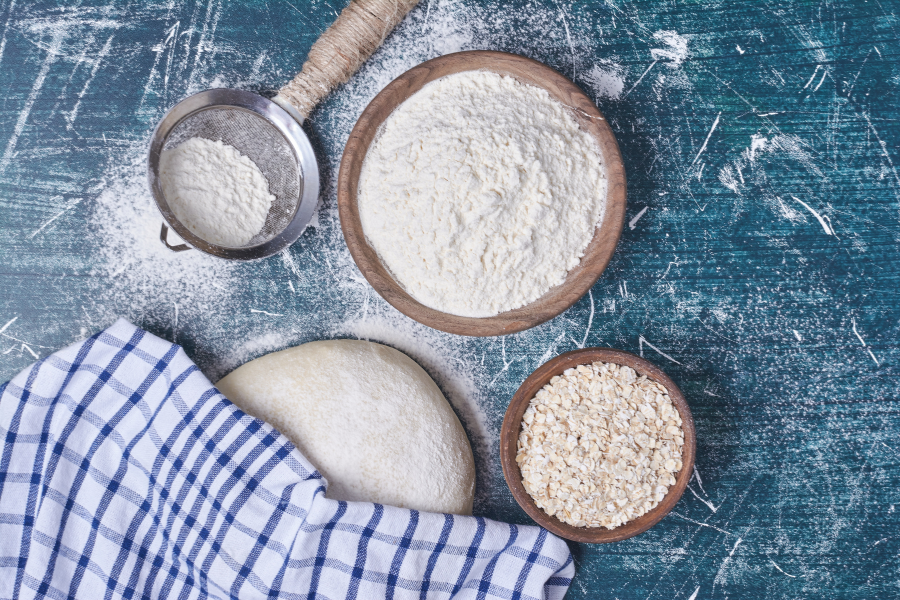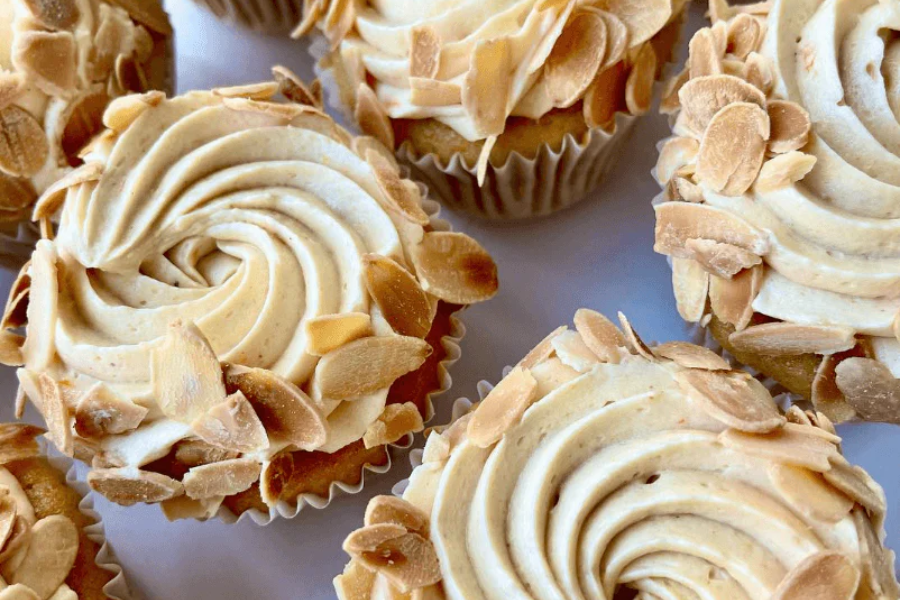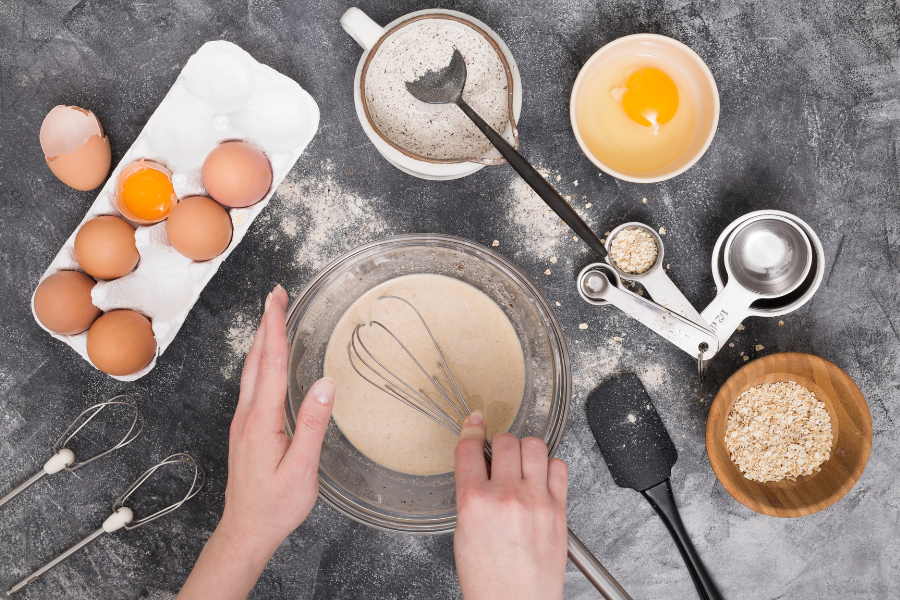Whether you’re a homemade bread baker, cake connoisseur or pastry pro, every home baker should keep a few different types of flour in their cupboard. But sometimes, even for the most experienced of amateur bakers, knowing which type of flour to reach for and when can be tricky! Choose the wrong one, and the texture, flavour or look of the treat can end up completely different to how you wanted!
In this article, we will explain what flour is made of, explore the function of flour and run through the common flour types you will come across and when to use them.
What is flour made of?
For something that is used in pretty much everything, have you ever sat and thought about what flour even is? Flour is a powder consisting of milled cereal grains, nuts and seeds. In the UK, the most common ingredient for flour is wheat, with around 85% of the flour we consume coming from wheat grains.
In the milling process, a wheat seed is split into three separate components - the endosperm, bran and germ - and ground into a fine powder. The endosperm is the largest part and contains the starch, which gives flour its structure. The bran, the outer layer, is rich in fibre, while the germ, which contains essential oils and nutrients, provides some of the flour’s flavour and nutritional value. Depending on how much of these components are included, different types of flour are created, which is why they can vary in texture, colour, and use in baking.
What is the function of flour in baking?
Depending on the goods you’re baking, flour has a number of different functions in baking, notably building structure, binding ingredients, and improving texture.
When flour is mixed with liquids, it absorbs moisture and helps to bind the ingredients together. This process is essential for creating the structure of the bake. As the dough is mixed or batter kneaded, the proteins in the flour - glutenin and gliadin - combine to form gluten. This process gives baked goods their elasticity and chewiness. This is particularly important in recipes like bread, where the gluten helps the dough rise and hold its shape.
The amount of gluten that is created depends on the type of flour used. Strong white bread flour, for example, has a higher protein content and creates more gluten, which is why it’s used for structure bread loaves. Plain flour, on the other hand, has a lower protein content and forms less gluten, which is why it achieves a delicate texture in cakes and pastries.
Bleached vs. unbleached flour
When browsing the home baking aisle in your local supermarket, you may find some bags of flour with an ‘unbleached’ label on. In the UK and Europe, however, this is an unnecessary addition, as all flour is unbleached by law. This means that in the UK and Europe, flour is legally prohibited from being treated with chemicals to alter its colour or texture.
Some countries, such as the US, don’t have this law, and so can bleach their flour to achieve a whiter colour, finer grain and softer texture. This bleaching process typically uses chemicals such as chlorine, potassium bromate or benzoyl peroxide, which break down some of the proteins and starches in the flour, resulting in a softer, more refined product. The final product is often lighter in colour and texture but may have less nutritional value due to the breakdown of natural components during bleaching.
Different types of flour
Now that you know what flour is and why it’s used in baking, you might be wondering about the different types of flour and their individual uses. Let’s explore some of the most common flour types and when you’d choose to reach for them.
Plain flour
The most commonly used flour in UK kitchens, plain flour is suitable for a wide range of recipes. Otherwise known as white flour or all-purpose flour, plain flour contains around 75% of the wheat grain, retaining some of the natural nutrients and flavour while being refined to create a finer texture.
It is incredibly versatile and can be used for a huge number of different bakes, including cakes, biscuits, pastries and pancakes! Because of its versatility, plain flour can often be used as a substitute for other flours, however you may need to add additional ingredients to ensure you achieve the properties of the replaced ingredient. In place of self-raising flour, for example, you’d have to combine plain flour with baking powder or other leavening agents to achieve the rise in cakes or scones!
Strong white bread flour
As suggested by its name, strong white bread flour is the best choice for structured, yeast-based breads, such as rolls, pizza dough and focaccia. Because it is higher in protein, strong white bread flour develops higher levels of gluten during the kneading process, resulting in a better rise and chewier texture than plain flour.
When making recipes that rely on yeast, such as classic loaves, baguettes, or enriched doughs like brioche, strong white bread flour is the ideal option. Its higher gluten content provides the elasticity needed to trap air bubbles during proving, ensuring the bread has a lighter texture once baked. However, this flour is less suitable for non-yeast recipes, such as cakes or biscuits, as the higher protein content can lead to a denser, tougher texture.
Self-raising flour
Self-raising flour is a versatile staple in baking. A combination of plain flour with added raising agents, such as baking powder, and a small amount of salt, this pre-mixed blend is designed to create light, airy bakes without the need to measure and mix leavening agents separately.
Ideal for quick breads, scones, cakes, and muffins, self-raising flour simplifies the baking process and saves time. However, it’s important to avoid using it in recipes where specific control over the rise is required, such as in delicate pastries or recipes that call for precise amounts of yeast or chemical leaveners. Its convenience makes it a popular choice for everyday bakes, but it’s not interchangeable with plain flour in all recipes, so it’s important to be mindful when substituting.
Wholemeal flour
Wholemeal flour is made from the entire wheat grain, giving it a coarser texture and darker colour. This flour is packed with nutrients, fibre, and a nutty flavour, making it an ideal choice for heavier breads, muffins, and scones.
However, its denser texture can sometimes make the finished product feel heavy. To achieve the best results, consider combining wholemeal flour with plain or strong flour to balance nutrition and texture, getting the best of both worlds in terms of flavour and texture.
Rye flour
Rye flour, made from rye grain, is a darker, denser alternative to wheat flour that has a distinct, slightly sour flavour. Its unique properties make it an excellent choice for traditional rye breads, such as pumpernickel and Finnish Rye Bread.
Due to its lower gluten content, rye flour often results in a denser bread with less rise. To counteract this, it’s common to blend rye flour with strong white bread flour for a lighter texture and improved structure. This combination allows you to enjoy the characteristic flavour of rye while achieving a more airy loaf.
Gluten-free flours
Gluten-free flours, such as rice flour, almond flour, and coconut flour, are essential for people who suffer from celiac disease or a gluten intolerance. These flours are made from non-wheat grains, and can be used to create a wide range of baked goods and food, including gluten-free bread, cakes, and even pasta.
Each type of gluten-free flour has unique properties, and they are often blended to achieve the desired texture and rise in recipes. Adding binders such as xanthan gum can help to mimic the elasticity of gluten, helping the ingredients bind together and improving the structure of your bakes.
Cornflour
Another gluten-free flour alternative, cornflour is a fine, starch-based flour that is usually used as a thickening agent rather than in traditional baking. Often used in recipes that require thickening without altering flavour, such as sauces, soups and custards, cornflour is a useful ingredient to have in the back of the cupboard!
Top tip: To avoid lumps, mix cornflour with a small amount of cold water before adding it into your hot liquids! This will help you to achieve the thicker, silkier texture your sauces or soups require!
How to choose the right flour for your recipe
Choosing the best flour for your bake is a balance of understanding the needs of the recipe and the different characteristics of each type of flour. Key factors to consider when making this choice include the protein content, texture, and flavour of the flour, as each of these elements will have an influence on the structure and taste of the final product.
If you find yourself without the exact flour your recipe calls for, substitutions can save the day. In many cases, plain flour can be used as a stand-in, with added raising agents to mimic self-raising flour. For bread recipes, mixing plain flour with a portion of strong white bread flour can help maintain structure. While substitutions often work in a pinch, they may slightly alter the texture or flavour, so it’s worth experimenting to find what works best for you.
How Gaya Bakery can help
If the sheer number of different flours available and the different ways of using them is more confusing than inspiring, Gaya Bakery has got you. We have a number of cakes, brownies and desserts that will taste as good as they look, wowing your loved ones without the need for the baking-aisle-panic!
We only use the finest ingredients we can get our hands on, making sure that every bite is yummy, crumbly delight for our customers.
Explore our range of cakes, desserts, and postal treats, or get in touch with us today for bespoke bakes!





